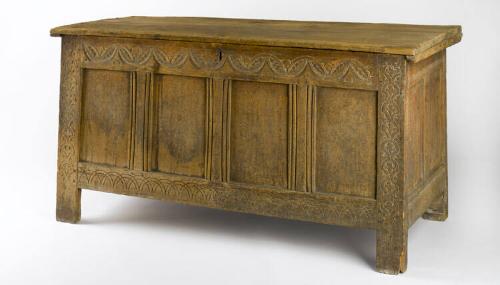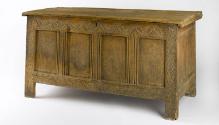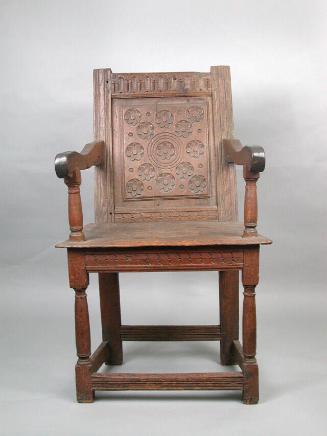Chest
Original OwnerOriginally owned by
William Phelps
(Anglo-American, 1599 - 1672)
Furniture MakerPossibly made by
Thomas Barber Sr.
(American, 1614 - 1662)
Furniture MakerPossibly made by
Thomas Barber Jr.
(American, 1641 - 1711)
Date1655-1665
MediumOak, yellow pine, iron
DimensionsPrimary Dimensions (height x width x depth): 29 5/8 x 59 3/16 x 25 1/16in. (75.2 x 150.3 x 63.7cm)
ClassificationsFurniture
Credit LineGift of Allys E. Tyler
Object number1956.72.0
DescriptionOak chest in the seventeenth century style with characteristics of the Trefoil Group, in the Barber Shop tradition. The top (original) has a band of incised molding at the front and carved gouges at the top side edges. A wide cleat, or a strip of wood, extends from the front to back on the underside of each side of the top. The interior left side of the chest has a lidded till. The front of the chest has a horizontal rail at the top over four plain recessed panels each separated by a short stile, over a horizontal rail at the bottom; these are all flanked by a corner stile that extends down to form the feet. The top rail is carved with an elaborate design of a single row of arches over a row of off-set inverted arches; the spaces between the arches are carved with carved pinwheels and trefoils. Each edge of each stile between the plain recessed panels has a vertical line of incised molding. The bottom rail is carved with a row of overlapping arches, or lunettes. Each corner stile is carved with a vertical row of trefoils, each inside a spade-shaped border. Each side of the chest consists of a rail over two plain, recessed panels separated by a single vertical stile, over a horizontal rail; these are all flanked by a corner stile. The rails each have a band of incised molding, as does each edge of the vertical stile between. Hardware includes a pair of cotter-pin hinges at the back edge of the lid, and a locking mechanism at the interior center of the top front rail and the lid above.
Condition: The chest has been disassembled. The back legs are shorter than the front, giving the chest a backward slant. The front right corner of the top is repaired. Two splits at the left edge of the top are repaired. The cotter-pin hinges have separated and the top is no longer attached to the chest. The spline on the bottom boards of the chest has split into at least two long strips and separated from the bottom boards. A metal plate is nailed in place to repair the bottom of the chest, at the back, to the right of the center. The sides and bottom of the till are missing.
Design and Construction Details:
Design. The incised molding on the top and front of the chest consists of a bead, fillet, half round, and a groove. The incised molding on the till lid and the sides consists of a step, groove and a half round.
Construction. The top is constructed of two boards that are joined with a spline. The cleats are joined with wooden pins and nails to the underside of the top. The chest is formed of riven panel-and-frame construction. The panels fit into grooves in the rails and stiles. The rails are joined to the stiles with mortise-and-tenon joints that are each secured with two wooden pins. The corner stiles extend the full height of the case. The till consists of a lid with a round hinge pin that is inserted into a mortise at the left side of the top front and back rails. The sides and bottom of the till slide into grooves in the same rails (sides and bottom of till are missing). The back of the chest consists of a horizontal rail over three plain recessed rails, each separated by a vertical stile over a horizontal rail; these are all flanked by a corner stile. The bottom of the chest is constructed of two yellow pine boards that run the full width of the chest and are joined with a spline. These boards slide into a groove on the interior lower side of the bottom rail on each side of the chest.
NotesHistorical Note: According to information provided by the donor and museum records, William Phelps (1599-1672) sailed to Boston on the ship "Mary and John" in 1630. He was one of the first settlers of Windsor, Connecticut, settling there in 1635. A notation on the back of a photograph in the object file incorrectly states that William Phelps sailed on the "William and Mary". (Lee 3/27/2012)Condition: The chest has been disassembled. The back legs are shorter than the front, giving the chest a backward slant. The front right corner of the top is repaired. Two splits at the left edge of the top are repaired. The cotter-pin hinges have separated and the top is no longer attached to the chest. The spline on the bottom boards of the chest has split into at least two long strips and separated from the bottom boards. A metal plate is nailed in place to repair the bottom of the chest, at the back, to the right of the center. The sides and bottom of the till are missing.
Design and Construction Details:
Design. The incised molding on the top and front of the chest consists of a bead, fillet, half round, and a groove. The incised molding on the till lid and the sides consists of a step, groove and a half round.
Construction. The top is constructed of two boards that are joined with a spline. The cleats are joined with wooden pins and nails to the underside of the top. The chest is formed of riven panel-and-frame construction. The panels fit into grooves in the rails and stiles. The rails are joined to the stiles with mortise-and-tenon joints that are each secured with two wooden pins. The corner stiles extend the full height of the case. The till consists of a lid with a round hinge pin that is inserted into a mortise at the left side of the top front and back rails. The sides and bottom of the till slide into grooves in the same rails (sides and bottom of till are missing). The back of the chest consists of a horizontal rail over three plain recessed rails, each separated by a vertical stile over a horizontal rail; these are all flanked by a corner stile. The bottom of the chest is constructed of two yellow pine boards that run the full width of the chest and are joined with a spline. These boards slide into a groove on the interior lower side of the bottom rail on each side of the chest.
Status
Not on view














